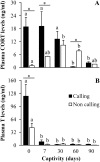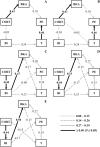Interplay among steroids, body condition and immunity in response to long-term captivity in toads
- PMID: 30464319
- PMCID: PMC6249311
- DOI: 10.1038/s41598-018-35495-0
Interplay among steroids, body condition and immunity in response to long-term captivity in toads
Abstract
Stressful experiences can promote harmful effects on physiology and fitness. However, stress-mediated hormonal and immune changes are complex and may be highly dependent on body condition. Here, we investigated captivity-associated stress effects, over 7, 30, 60, and 90 days on plasma corticosterone (CORT) and testosterone (T) levels, body index, and innate immunity (bacterial killing ability and phagocytosis of peritoneal cells) in toads (Rhinella icterica). Toads in captivity exhibited elevated CORT and decreased T and immunity, without changes in body index. The inter-relationships between these variables were additionally contrasted with those obtained previously for R. schneideri, a related species that exhibited extreme loss of body mass under the same captive conditions. While T and phagocytosis were positively associated in both species, the relationship between CORT and bacterial killing ability was dependent on body index alterations. While CORT and bacterial killing ability were positively associated for toads that maintained body index, CORT was negatively associated with body index in toads that lost body mass over time in captivity. In these same toads, body index was positively associated with bacterial killing ability. These results demonstrate that steroids-immunity inter-relationships arising from prolonged exposure to a stressor in toads are highly dependent on body condition.
Conflict of interest statement
The authors declare no competing interests.
Figures




Similar articles
-
Corticosterone transdermal application in toads (Rhinella icterica): Effects on cellular and humoral immunity and steroid plasma levels.J Exp Zool A Ecol Integr Physiol. 2017 Apr;327(4):200-213. doi: 10.1002/jez.2093. Epub 2017 Aug 23. J Exp Zool A Ecol Integr Physiol. 2017. PMID: 29356458
-
Captivity effects on immune response and steroid plasma levels of a Brazilian toad (Rhinella schneideri).J Exp Zool A Ecol Integr Physiol. 2017 Feb;327(2-3):127-138. doi: 10.1002/jez.2078. Epub 2017 Jun 28. J Exp Zool A Ecol Integr Physiol. 2017. PMID: 29356402
-
Acute stress, steroid plasma levels, and innate immunity in Brazilian toads.Gen Comp Endocrinol. 2019 Mar 1;273:86-97. doi: 10.1016/j.ygcen.2018.05.008. Epub 2018 May 8. Gen Comp Endocrinol. 2019. PMID: 29750968
-
Effects of acute restraint stress, prolonged captivity stress and transdermal corticosterone application on immunocompetence and plasma levels of corticosterone on the cururu Toad (Rhinella icterica).PLoS One. 2015 Apr 1;10(4):e0121005. doi: 10.1371/journal.pone.0121005. eCollection 2015. PLoS One. 2015. PMID: 25831055 Free PMC article.
-
Time-related immunomodulation by stressors and corticosterone transdermal application in toads.PLoS One. 2019 Sep 20;14(9):e0222856. doi: 10.1371/journal.pone.0222856. eCollection 2019. PLoS One. 2019. PMID: 31539413 Free PMC article.
Cited by
-
Wind Turbine Noise Behaviorally and Physiologically Changes Male Frogs.Biology (Basel). 2022 Mar 27;11(4):516. doi: 10.3390/biology11040516. Biology (Basel). 2022. PMID: 35453715 Free PMC article.
-
Reference Intervals in Combined Veterinary Clinical Examinations of Male Black-Spotted Pond Frogs (Pelophylax nigromaculatus).Animals (Basel). 2021 May 14;11(5):1407. doi: 10.3390/ani11051407. Animals (Basel). 2021. PMID: 34069152 Free PMC article.
-
Testosterone immunomodulation in free-living and captive Rhinella icterica male toads.Philos Trans R Soc Lond B Biol Sci. 2023 Jul 31;378(1882):20220118. doi: 10.1098/rstb.2022.0118. Epub 2023 Jun 12. Philos Trans R Soc Lond B Biol Sci. 2023. PMID: 37305916 Free PMC article.
-
The genetic history of Portugal over the past 5,000 years.Genome Biol. 2025 Aug 18;26(1):248. doi: 10.1186/s13059-025-03707-2. Genome Biol. 2025. PMID: 40826367 Free PMC article.
-
Validation of stable reference genes in Staphylococcus aureus to study gene expression under photodynamic treatment: a case study of SEB virulence factor analysis.Sci Rep. 2020 Oct 1;10(1):16354. doi: 10.1038/s41598-020-73409-1. Sci Rep. 2020. PMID: 33004977 Free PMC article.
References
-
- Sapolsky, R. M. Endocrinology of the stress response. In Becker, J. B., Reedlove, S. M., Crews, D., McCarthy, M. M. (eds), Behavioral Endocrinology. (Cambridge, MIT press 409–450, 2002).
-
- Sapolsky RM, Romero LM, Munck AU. How do glucocorticoids influence stress responses? Integrating permissive, suppressive, stimulatory and preparative actions. Endocr. Rev. 2000;21(1):55–89. - PubMed
Publication types
MeSH terms
Substances
Grants and funding
- 142455/2013-0/Ministry of Science, Technology and Innovation | Conselho Nacional de Desenvolvimento Científico e Tecnológico (National Council for Scientific and Technological Development)/International
- 2013/00900-1/Fundação de Amparo à Pesquisa do Estado de São Paulo (São Paulo Research Foundation)/International
- 2014/16320-7/Fundação de Amparo à Pesquisa do Estado de São Paulo (São Paulo Research Foundation)/International
LinkOut - more resources
Full Text Sources

